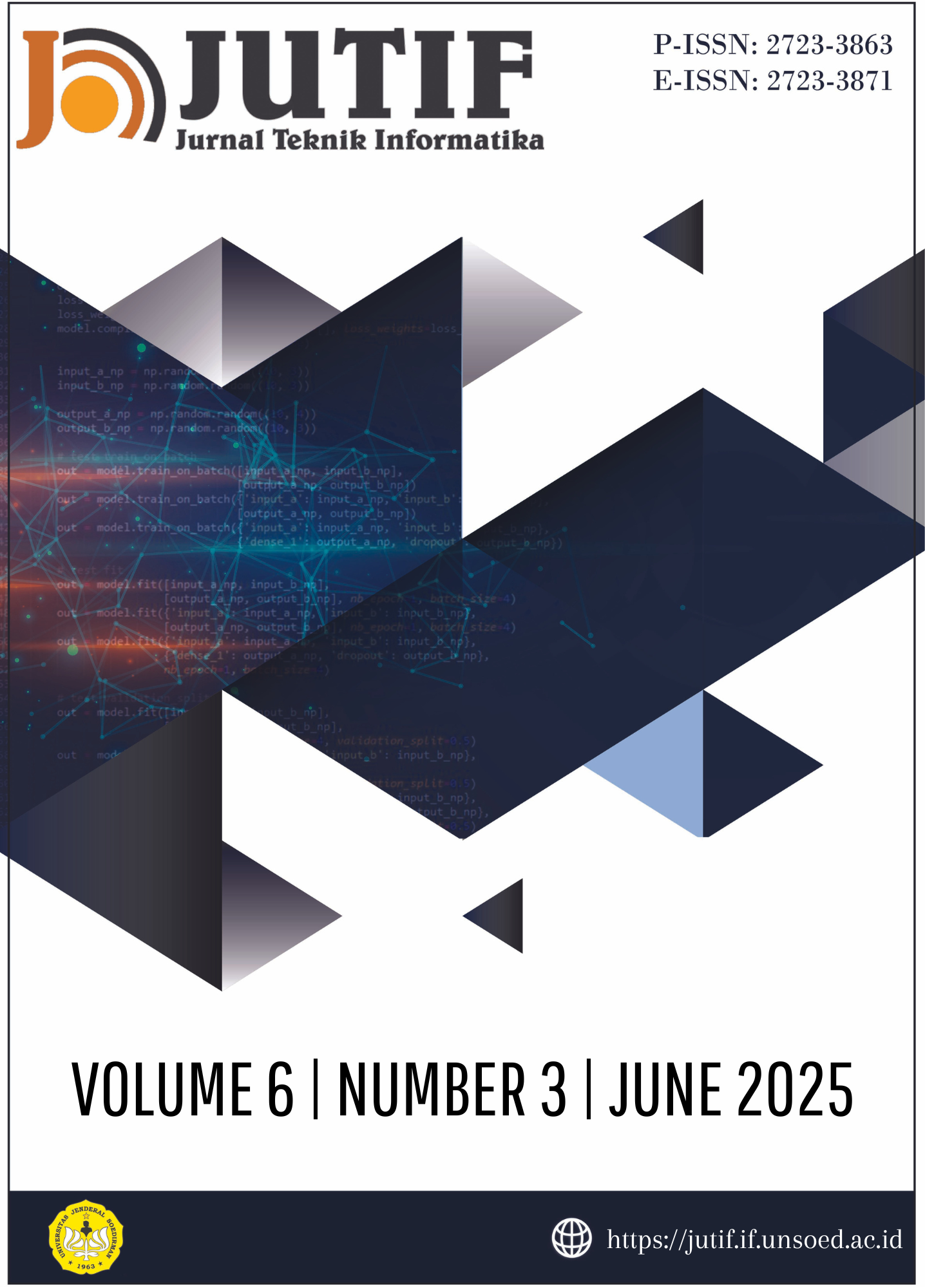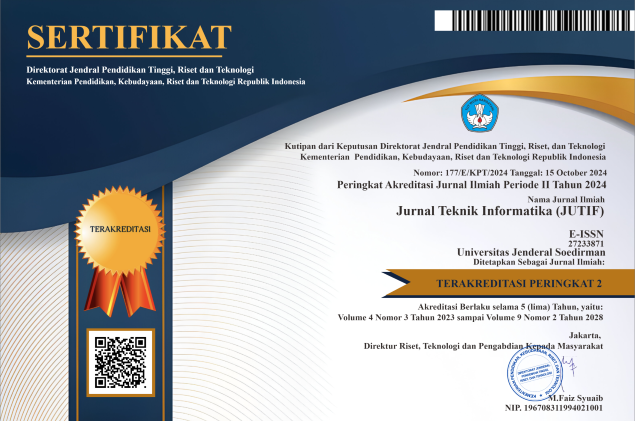A Hybrid Recommendation System for Pregnancy-Safe Skincare: Integrating Keyword-Based and Rule-Based Classification with Content-Based Filtering
DOI:
https://doi.org/10.52436/1.jutif.2025.6.3.4646Keywords:
Content-based filtering, Keyword-based classification, Pregnancy-safe skincare, Recommendation system, Rule-based classificationAbstract
Pregnant women struggle to select safe skincare products, often relying on social media and blog searches, and manual ingredient checking. Choosing safe ingredients is essential, as exposure to unsafe substances may lead to teratogenic effects and endocrine disruption, which can result in fetal abnormalities such as retinoic acid embryopathy and neurodevelopmental disorders. Exposure to retinoids, for instance, has been associated with a 20–30% incidence of fetal retinoid syndrome in affected pregnancies. This study develops an integrated recommendation system using three techniques: (1) keyword-based classification with regular expressions to detect 50 unsafe ingredients across 8 categories; (2) rule-based classification using IF-THEN statements matching products with 5 pregnancy-related skin conditions; and (3) content-based filtering utilizing TF-IDF vectorization and cosine similarity for safer alternatives. The system achieved 86.25% accuracy in safety classification, with high recall (97.50%) indicating strong ability to identify safe products. However, moderate precision (79.59%) suggests some unsafe products were misclassified as safe, highlighting need for improvement in safety-critical contexts. Pilot user evaluation using ResQue framework with 10 participants yielded scores of 4.50–4.85 across 8 dimensions, achieving 4.65 overall average. This research demonstrates effective integration of multiple recommendation methods in context-sensitive applications, enabling safer product selection during pregnancy. By providing accessible, personalized, and evidence-based information, the system enables pregnant women to make informed skincare decisions and continue their routines despite limited access to healthcare services.
Downloads
References
K. H. Tyler, Cutaneous Disorders of Pregnancy. Cham, Switzerland: Springer International Publishing, 2020, doi: 10.1007/978-3-030-49285-4.
S. Musaei, “The Effect of Pregnancy on the Skin,” Eurasian Journal of Chemical, Medicinal and Petroleum Research, vol. 2, no. 1, pp. 17-23, 2023.
L. Zhao, X. Fu, and H. Cheng, “Prevention of Melasma during Pregnancy: Risk factors and Photoprotection-Focused Strategies,” Clinical Cosmetic and Investigational Dermatology,vol. 17, pp. 2301-2310, 2024, doi: 10.2147/ccid.s488663.
Ö. Kutlu et al., “Acne in pregnancy: A prospective multicenter, cross‐sectional study of 295 patients in Turkey,” International Journal of Dermatology, vol. 59, no. 9, pp. 1098–1105, Jun. 2020, doi: 10.1111/ijd.14999.
C. Marie, R. Garlantézec, R. Béranger, and A. Ficheux, “Use of Cosmetic Products in Pregnant and Breastfeeding Women and Young Children: Guidelines for Interventions during the Perinatal Period from the French National College of Midwives,” Journal of Midwifery & Women’s Health, vol. 67, no. S1, 2022, doi: 10.1111/jmwh.13428.
K. D. Loureiro et al., “Minor malformations characteristic of the retinoic acid embryopathy and other birth outcomes in children of women exposed to topical tretinoin during early pregnancy,” American Journal of Medical Genetics Part A, vol. 136A, no. 2, pp. 117–121, Jun. 2005, doi: 10.1002/ajmg.a.30744.
P. Brzezinski et al., “A Multicenter Cohort Study Evaluating the Teratogenic Effects of Isotretinoin on Neonates,” Children, vol. 9, no. 11, p. 1612, 2022, doi: 10.3390/children9111612.
K. M. Veena, K. M. Shenoy, and K. B. A. Shenoy, “Performance comparison of machine learning classification algorithms,” in Proceedings of the International Conference on Intelligent Computing and Applications, Singapore: Springer, 2018, pp. 489–497, doi: 10.1007/978-981-13-1813-9_49.
N. S. Suryawanshi, “Predicting consumer behavior in e-commerce using recommendation systems,” Int. J. Innov. Sci. Res. Technol., vol. 4, no. 9, pp. 806-813, 2024, doi: 10.38124/ijisrt/IJISRT19SEP1550.
Y. Afoudi, M. Lazaar, and M. A. Achhab, “Hybrid recommendation system combined content-based filtering and collaborative prediction using artificial neural network,” Simulation Modelling Practice and Theory, vol. 113, p. 102375, Jul. 2021, doi: 10.1016/j.simpat.2021.102375.
C. Dm, S. Kk, S. Gv, and S. Goravanakolla, “Content based book recommendation system,” International Research Journal Of Modernization In Engineering Technology And Science, Aug. 2023, doi: 10.56726/irjmets44243.
D. Chopra, P. Arora, and Jagan Institute of Management Studies, Rohini, Sector 5, Delhi, “The Manager’s Reading List: A Personalized book recommendation system for management growth,” Journal of Harbin Engineering University, vol. 44, no. 6, Jun. 2023.
T. Z. L. Kyaw, S. Uttama, and P. Panwong, “Leveraging Ingredient Profiles in Content-Based Skincare Product Recommendation,” in Proc. 8th International Conference on Information Technology (InCIT), 2024, pp. 319-324, doi: 10.1109/incit63192.2024.10810620.
S. Tanveer, S. Khatoon, H. U. Begum, and U. Zainab, “Korean Skin Care Recommendation System,” Department of CSE, vol. 12, no. 2, 2024.
Z. Huang, B. Jin, H. Zhao, Q. Liu, D. Lian, B. Tengfei, and E. Chen, “Personal or General? A Hybrid Strategy with Multi-factors for News Recommendation,” ACM Transactions on Office Information Systems, vol. 41, no. 2, pp. 1-29, 2022, doi: 10.1145/3555373.
P. Pu and L. Chen, “A User-Centric evaluation framework of recommender systems,” in Proc. ACM RecSys 2010 Workshop on User-Centric Evaluation of Recommender Systems and Their Interfaces (UCERSTI), 2010.
M. Khder, “Web scraping or web crawling: state of art, techniques, approaches and application,” International Journal of Advances in Soft Computing and Its Applications, vol. 13, no. 3, pp. 145–168, Nov. 2021, doi: 10.15849/ijasca.211128.11.
Cristina Arhiliuc and Raf Guns, “Content-based classification of research articles: comparing keyword extraction, BERT, and random forest classifiers”, in Proceedings of ISSI 2023 – the 19th International Conference of the International Society for Scientometrics and Informetrics, Bloomington, Indiana, Jul. 2023, vol. 1, pp. 43–63. doi: 10.5281/zenodo.8305874.
A. K. Varshney and V. Torra, “Literature review of the recent trends and applications in various fuzzy Rule-Based systems,” International Journal of Fuzzy Systems, vol. 25, no. 6, pp. 2163–2186, May 2023, doi: 10.1007/s40815-023-01534-w.
J. Friedl, Mastering regular expressions. “O’Reilly Media, Inc.,” 2006.
H. Liu, X. Chen, and X. Liu, “A study of the application of weight distributing method combining sentiment dictionary and TF-IDF for text sentiment analysis,” IEEE Access, vol. 10, pp. 32280–32289, Jan. 2022, doi: 10.1109/ACCESS.2022.3160172.
H. Kim, J. Baek, and K. Chung, “Optimization of Associative Knowledge Graph using TF-IDF based Ranking Score,” Applied Sciences, vol. 10, no. 13, p. 4590, 2020, doi: 10.3390/app10134590.
H. J. Armadhani, P. Permana, and A. T. Wibowo, “Movie Recommendation System Based on Synopsis Using Content-Based Filtering with TF-IDF and Cosine Similarity,” Intl. Journal on ICT, vol. 9, no. 2, pp. 1-14, 2023, doi: 10.21108/ijoict.v9i2.747.
G. Yunanda, D. Nurjanah, and S. Meliana, “Recommendation System from Microsoft News Data using TF-IDF and Cosine Similarity Methods,” Building of Informatics Technology and Science (BITS), vol. 4, no. 1, 2022, doi: 10.47065/bits.v4i1.1670.
K. Jones, L. M. Wessel, K. Schäfer, and M. Á. Tapia-Laliena, “Use of cosmetics in pregnancy and neurotoxicity: Can it increase the risk of congenital enteric neuropathies?,” Biomolecules, vol. 14, no. 8, p. 984, 2024, doi: 10.3390/biom14080984.
I. B. Putra, N. K. Jusuf, and N. K. Dewi, “Skin changes and safety profile of topical products during pregnancy,” J. Clin. Aesthet. Dermatol., vol. 15, no. 2, pp. 49–57, 2022.
V. M. Patel, R. A. Schwartz, and W. C. Lambert, “Safety of topical dermatologic medications in pregnancy, ” J. Drugs Dermatol., vol. 15, no. 7, pp. 830–834, 2016.
S. Ly, K. Kamal, P. Manjaly, J. S. Barbieri, and A. Mostaghimi, “Treatment of acne vulgaris during pregnancy and lactation: A Narrative review,” Dermatology and Therapy, vol. 13, no. 1, pp. 115-130, 2022, doi: 10.1007/s13555-022-00854-3.
L. L. Bio and J. J. Cies, “Lack of pregnancy warnings on over-the-counter dermatologic products containing potentially harmful hydroquinone,” Journal of Perinatology, vol. 37, no. 7, pp. 778-781, 2017, doi: 10.1038/jp.2017.35.
J. Zhao, Y. Wang, L. Jiang, and Y. Mu, “The application of skin care product in acne treatment,” Dermatologic Therapy, vol. 33, no. 6, 2020, doi: 10.1111/dth.14287.
A. K. Mohiuddin, “Skin lightening & management of hyperpigmentation,” Pharmaceutical Sciences & Analytical Research Journal, vol. 2, no. 2, 2019, doi: 10.28933/ajodrr-2019-04-2001.
M. Rendon, M. Berneburg, I. Arellano, and M. Picardo, “Treatment of melasma,” Journal of the American Academy of Dermatology, vol. 54, no. 5, pp. S272-S281, 2006, doi: 10.1016/j.jaad.2005.12.039.
K. Korgavkar and F. Wang, “Stretch marks during pregnancy: a review of topical prevention,” British Journal of Dermatology, vol. 172, no. 3, pp. 606-615, 2014, doi: 10.1111/bjd.13426.
J. Á. G. Hernández, D. M. González, M. P. Castillo, and T. F. Falcón, “Use of a specific anti‐stretch mark cream for preventing or reducing the severity of striae gra[1] K. H. Tyler, Cutaneous Disorders of Pregnancy. Cham, Switzerland: Springer International Publishing, 2020, doi: 10.1007/978-3-030-49285-4.
S. Musaei, “The Effect of Pregnancy on the Skin,” Eurasian Journal of Chemical, Medicinal and Petroleum Research, vol. 2, no. 1, pp. 17-23, 2023.
Bolanca et al., “Chloasma – the mask of pregnancy,” Coll. Antropol., vol. 32, pp. 139–141, 2008.
L. Zhao, X. Fu, and H. Cheng, “Prevention of Melasma during Pregnancy: Risk factors and Photoprotection-Focused Strategies,” Clinical Cosmetic and Investigational Dermatology, vol. 17, pp. 2301-2310, 2024, doi: 10.2147/ccid.s488663.
Ö. Kutlu et al., “Acne in pregnancy: A prospective multicenter, cross‐sectional study of 295 patients in Turkey,” International Journal of Dermatology, vol. 59, no. 9, pp. 1098–1105, Jun. 2020, doi: 10.1111/ijd.14999.
C. Marie, R. Garlantézec, R. Béranger, and A. Ficheux, “Use of Cosmetic Products in Pregnant and Breastfeeding Women and Young Children: Guidelines for Interventions during the Perinatal Period from the French National College of Midwives,” Journal of Midwifery & Women’s Health, vol. 67, no. S1, 2022, doi: 10.1111/jmwh.13428.
H. W. Lim et al., “Photoprotection in pregnancy: addressing safety concerns and optimizing skin health,” Frontiers in Medicine, vol. 12, Mar. 2025, doi: 10.3389/fmed.2025.1563369.
A. L. Williams, N. D. Pace, and J. M. DeSesso, “Teratogen update: Topical use and third‐generation retinoids,” Birth Defects Research, vol. 112, no. 15, pp. 1105–1114, Jul. 2020, doi: 10.1002/bdr2.1745.
K. D. Loureiro et al., “Minor malformations characteristic of the retinoic acid embryopathy and other birth outcomes in children of women exposed to topical tretinoin during early pregnancy,” American Journal of Medical Genetics Part A, vol. 136A, no. 2, pp. 117–121, Jun. 2005, doi: 10.1002/ajmg.a.30744.
P. Brzezinski et al., “A Multicenter Cohort Study Evaluating the Teratogenic Effects of Isotretinoin on Neonates,” Children, vol. 9, no. 11, p. 1612, 2022, doi: 10.3390/children9111612.
P. A. Bommarito et al., “Prenatal exposure to consumer product chemical mixtures and size for gestational age at delivery,” Environmental Health, vol. 20, no. 1, Jun. 2021, doi: 10.1186/s12940-021-00724-z.
H. Li et al., “Maternal cosmetics use during pregnancy and risks of adverse outcomes: a prospective cohort study,” Scientific Reports, vol. 9, no. 1, May 2019, doi: 10.1038/s41598-019-44546-z.
K. Jones, L. M. Wessel, K. Schäfer, and M. Á. Tapia-Laliena, “Use of cosmetics in pregnancy and neurotoxicity: Can it increase the risk of congenital enteric neuropathies?,” Biomolecules, vol. 14, no. 8, p. 984, 2024, doi: 10.3390/biom14080984.
L. Almeida-Toledano et al., “Effect of prenatal phthalate exposure on fetal development and maternal/neonatal health consequences: A systematic review,” The Science of the Total Environment, vol. 950, p. 175080, Jul. 2024, doi: 10.1016/j.scitotenv.2024.175080.
J. Lee, H. Yoon, S. Kim, C. Lee, J. Lee, and S. Yoo, “Deep learning‐based skin care product recommendation: A focus on cosmetic ingredient analysis and facial skin conditions,” Journal of Cosmetic Dermatology, vol. 23, no. 6, pp. 2066–2077, Feb. 2024, doi: 10.1111/jocd.16218.
K. S. Y. Putri, N. I. M. A. D. Suarjaya, and N. W. O. Vihikan, “Sistem Rekomendasi Skincare Menggunakan Metode Content Based Filtering dan Collaborative Filtering,” Decode Jurnal Pendidikan Teknologi Informasi, vol. 4, no. 3, pp. 764–774, Aug. 2024, doi: 10.51454/decode.v4i3.601.
K. M. Veena, K. M. Shenoy, and K. B. A. Shenoy, “Performance comparison of machine learning classification algorithms,” in Communications in computer and information science, 2018, pp. 489–497. doi: 10.1007/978-981-13-1813-9_49.
N. S. Suryawanshi, “Predicting consumer behavior in e-commerce using recommendation systems,” Int. J. Innov. Sci. Res. Technol., vol. 4, no. 9, pp. 806-813, 2024, doi: 10.38124/ijisrt/IJISRT19SEP1550.
Y. Afoudi, M. Lazaar, and M. A. Achhab, “Hybrid recommendation system combined content-based filtering and collaborative prediction using artificial neural network,” Simulation Modelling Practice and Theory, vol. 113, p. 102375, Jul. 2021, doi: 10.1016/j.simpat.2021.102375.
C. Dm, S. Kk, S. Gv, and S. Goravanakolla, “Content based book recommendation system,” International Research Journal Of Modernization In Engineering Technology And Science, Aug. 2023, doi: 10.56726/irjmets44243.
D. Chopra, P. Arora, and Jagan Institute of Management Studies, Rohini, Sector 5, Delhi, “The Manager’s Reading List: A Personalized book recommendation system for management growth,” Journal of Harbin Engineering University, vol. 44, no. 6, Jun. 2023.
T. Z. L. Kyaw, S. Uttama, and P. Panwong, “Leveraging Ingredient Profiles in Content-Based Skincare Product Recommendation,” in Proc. 8th International Conference on Information Technology (InCIT), 2024, pp. 319-324, doi: 10.1109/incit63192.2024.10810620.
S. Tanveer, S. Khatoon, H. U. Begum, and U. Zainab, “Korean Skin Care Recommendation System,” Department of CSE, vol. 12, no. 2, 2024.
Z. Huang, B. Jin, H. Zhao, Q. Liu, D. Lian, B. Tengfei, and E. Chen, “Personal or General? A Hybrid Strategy with Multi-factors for News Recommendation,” ACM Transactions on Office Information Systems, vol. 41, no. 2, pp. 1-29, 2022, doi: 10.1145/3555373.
P. Pu, L. Chen, and R. Hu, “A user-centric evaluation framework for recommender systems,” in Proceedings of the Fifth ACM Conference on Recommender Systems, pp. 157–164, Oct. 2011, doi: 10.1145/2043932.2043962.
G. Karystianis, K. Thayer, M. Wolfe, and G. Tsafnat, “Evaluation of a rule-based method for epidemiological document classification towards the automation of systematic reviews,” Journal of Biomedical Informatics, vol. 70, pp. 27–34, Apr. 2017, doi: 10.1016/j.jbi.2017.04.004.
Y. Deldjoo, M. Elahi, M. Quadrana, and P. Cremonesi, “Using visual features based on MPEG-7 and deep learning for movie recommendation,” International Journal of Multimedia Information Retrieval, vol. 7, no. 4, pp. 207–219, Jun. 2018, doi: 10.1007/s13735-018-0155-1.
G. Lee, X. Jiang, and N. Parde, “A Content-based Skincare Product Recommendation System,” 2023 22nd International Conference on Machine Learning and Applications (ICMLA), pp. 2039–2043, Dec. 2023, doi: 10.1109/icmla58977.2023.00308.
M. Khder, “Web scraping or web crawling: state of art, techniques, approaches and application,” International Journal of Advances in Soft Computing and Its Applications, vol. 13, no. 3, pp. 145–168, Nov. 2021, doi: 10.15849/ijasca.211128.11.
Cristina Arhiliuc and Raf Guns, “Content-based classification of research articles: comparing keyword extraction, BERT, and random forest classifiers”, in Proceedings of ISSI 2023 – the 19th International Conference of the International Society for Scientometrics and Informetrics, Jul. 2023, vol. 1, pp. 43–63. doi: 10.5281/zenodo.8305874.
A. K. Varshney and V. Torra, “Literature review of the recent trends and applications in various fuzzy Rule-Based systems,” International Journal of Fuzzy Systems, vol. 25, no. 6, pp. 2163–2186, May 2023, doi: 10.1007/s40815-023-01534-w.
J. Friedl, Mastering regular expressions. “O’Reilly Media, Inc.,” 2006.
H. Liu, X. Chen, and X. Liu, “A study of the application of weight distributing method combining sentiment dictionary and TF-IDF for text sentiment analysis,” IEEE Access, vol. 10, pp. 32280–32289, Jan. 2022, doi: 10.1109/ACCESS.2022.3160172.
H. Kim, J. Baek, and K. Chung, “Optimization of Associative Knowledge Graph using TF-IDF based Ranking Score,” Applied Sciences, vol. 10, no. 13, p. 4590, 2020, doi: 10.3390/app10134590.
H. J. Armadhani, P. Permana, and A. T. Wibowo, “Movie Recommendation System Based on Synopsis Using Content-Based Filtering with TF-IDF and Cosine Similarity,” Intl. Journal on ICT, vol. 9, no. 2, pp. 1-14, 2023, doi: 10.21108/ijoict.v9i2.747.
G. Yunanda, D. Nurjanah, and S. Meliana, “Recommendation System from Microsoft News Data using TF-IDF and Cosine Similarity Methods,” Building of Informatics Technology and Science (BITS), vol. 4, no. 1, 2022, doi: 10.47065/bits.v4i1.1670.
Christine, “15 minute beauty fanatic,” 15 Minute Beauty Fanatic. https://www.15minutebeauty.com/ (accessed Jun. 18, 2025).
S. Sathyanarayanan, “Confusion Matrix-Based Performance Evaluation Metrics,” African Journal of Biomedical Research, pp. 4023–4031, Nov. 2024, doi: 10.53555/ajbr.v27i4s.4345.
B. Gaye and A. Wulamu, “Sentiment analysis of text classification algorithms using Confusion Matrix,” in Communications in computer and information science, 2019, pp. 231–241. doi: 10.1007/978-981-15-1922-2_16.
D. R. Kim et al., “An Open Label Pilot Study of Transcranial Magnetic Stimulation for Pregnant Women with Major Depressive Disorder,” Journal of Women S Health, vol. 20, no. 2, pp. 255–261, Feb. 2011, doi: 10.1089/jwh.2010.2353.
C. Knight-Agarwal, D. L. Davis, L. Williams, R. Davey, R. Cox, and A. Clarke, “Development and pilot testing of the Eating4Two mobile phone app to monitor gestational weight gain,” JMIR Mhealth and Uhealth, vol. 3, no. 2, p. e44, Jun. 2015, doi: 10.2196/mhealth.4071.
S. Q. Wang and H. W. Lim, “Highlights and implications of the 2019 proposed rule on sunscreens by the US Food and Drug Administration,” Journal of the American Academy of Dermatology, vol. 81, no. 2, pp. 650–651, Apr. 2019, doi: 10.1016/j.jaad.2019.04.007.
I. B. Putra, N. K. Jusuf, and N. K. Dewi, “Skin changes and safety profile of topical products during pregnancy,” J. Clin. Aesthet. Dermatol., vol. 15, no. 2, pp. 49–57, 2022.
V. M. Patel, R. A. Schwartz, and W. C. Lambert, “Safety of topical dermatologic medications in pregnancy, ” J. Drugs Dermatol., vol. 15, no. 7, pp. 830–834, 2016.
S. Ly, K. Kamal, P. Manjaly, J. S. Barbieri, and A. Mostaghimi, “Treatment of acne vulgaris during pregnancy and lactation: A Narrative review,” Dermatology and Therapy, vol. 13, no. 1, pp. 115-130, 2022, doi: 10.1007/s13555-022-00854-3.
L. L. Bio and J. J. Cies, “Lack of pregnancy warnings on over-the-counter dermatologic products containing potentially harmful hydroquinone,” Journal of Perinatology, vol. 37, no. 7, pp. 778-781, 2017, doi: 10.1038/jp.2017.35.
J. Zhao, Y. Wang, L. Jiang, and Y. Mu, “The application of skin care product in acne treatment,” Dermatologic Therapy, vol. 33, no. 6, 2020, doi: 10.1111/dth.14287.
A. K. Mohiuddin, “Skin lightening & management of hyperpigmentation,” Pharmaceutical Sciences & Analytical Research Journal, vol. 2, no. 2, 2019, doi: 10.28933/ajodrr-2019-04-2001.
M. Rendon, M. Berneburg, I. Arellano, and M. Picardo, “Treatment of melasma,” Journal of the American Academy of Dermatology, vol. 54, no. 5, pp. S272-S281, 2006, doi: 10.1016/j.jaad.2005.12.039.
K. Korgavkar and F. Wang, “Stretch marks during pregnancy: a review of topical prevention,” British Journal of Dermatology, vol. 172, no. 3, pp. 606-615, 2014, doi: 10.1111/bjd.13426.
J. Á. G. Hernández, D. M. González, M. P. Castillo, and T. F. Falcón, “Use of a specific anti‐stretch mark cream for preventing or reducing the severity of striae gravidarum. Randomized, double‐blind, controlled trial,” International Journal of Cosmetic Science, vol. 35, no. 3, pp. 233-237, 2012, doi: 10.1111/ics.12029.
N. S. Wahyuni and N. F. P. Putra, “Rancangan Aplikasi Rekomendasi Produk Skincare untuk Ibu Hamil Menggunakan Metode Prototype,” Repeater, vol. 2, no. 4, pp. 136-148, 2024, doi: 10.62951/repeater.v2i4.209.
vidarum. Randomized, double‐blind, controlled trial,” International Journal of Cosmetic Science, vol. 35, no. 3, pp. 233-237, 2012, doi: 10.1111/ics.12029.
N. S. Wahyuni and N. F. P. Putra, “Rancangan Aplikasi Rekomendasi Produk Skincare untuk Ibu Hamil Menggunakan Metode Prototype,” Repeater, vol. 2, no. 4, pp. 136-148, 2024, doi: 10.62951/repeater.v2i4.209.
Additional Files
Published
How to Cite
Issue
Section
License
Copyright (c) 2025 Jihan Syahira Adnanda Putri, Kholid Haryono

This work is licensed under a Creative Commons Attribution 4.0 International License.



























